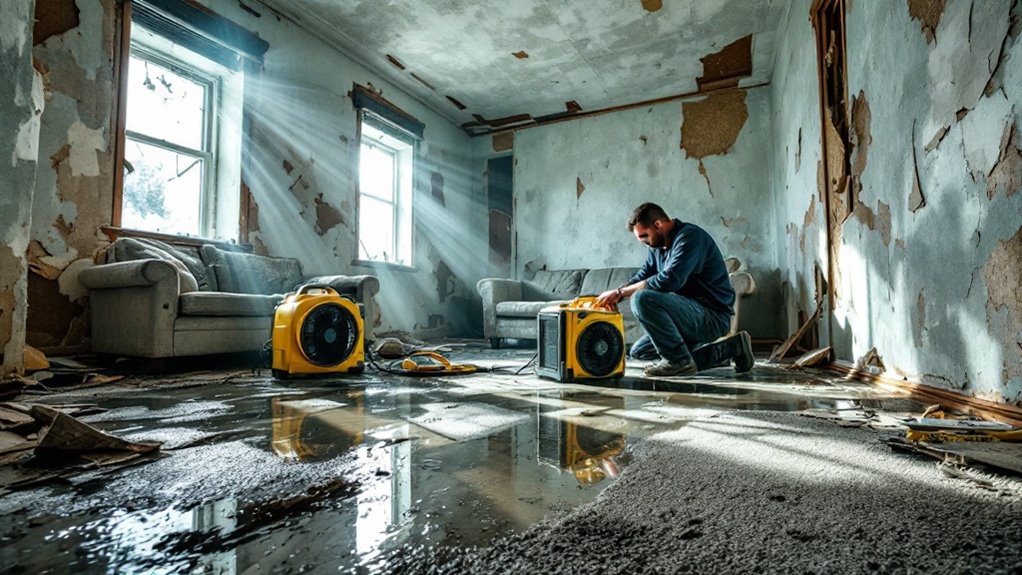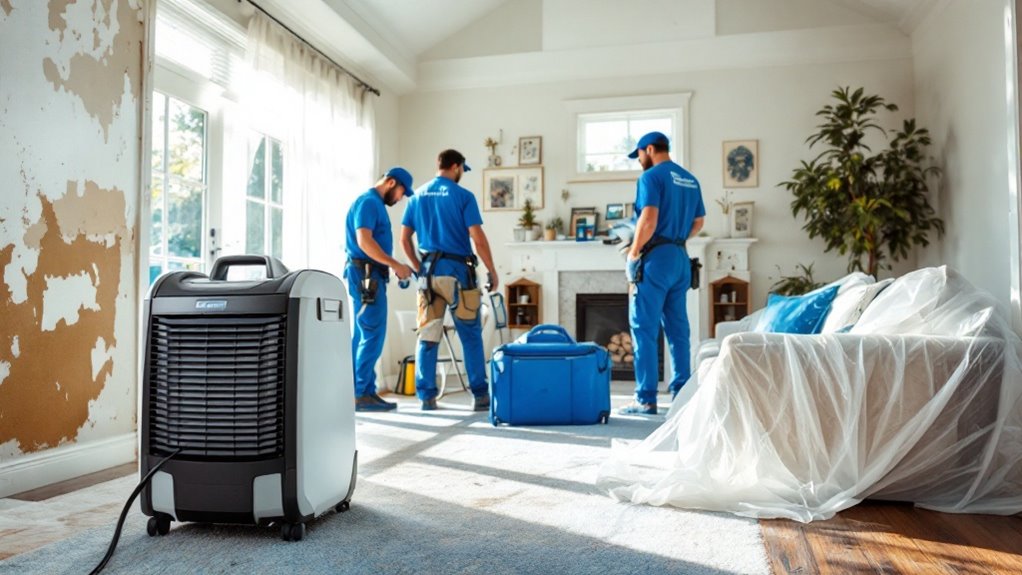Imagine maneuvering your home like a tightrope walker, balancing safety and comfort during water damage restoration. You might wonder if staying put is the right choice. It’s a decision that hinges on various factors, from the severity of the damage to potential health risks lurking in the air. Understanding these aspects can help you make a more informed choice about whether to stay or go. What should you consider before making that call?
Key Takeaways
- Staying home during restoration allows you to monitor progress and communicate directly with the restoration team.
- Health risks from mold and structural damage may necessitate temporary relocation for safety.
- Restoration activities can create noise and disruption, impacting daily routines and comfort.
- Vulnerable individuals, like children and the elderly, may require extra caution and consideration during restoration.
- Insurance may cover temporary relocation, providing options for staying with friends, family, or at hotels.
Understanding the Scope of Water Damage

When you experience water damage, it’s vital to grasp the full extent of the situation. Start by identifying the source, whether it’s a burst pipe, flooding, or an appliance leak. Understanding how long the water’s been present is significant, as prolonged exposure can lead to mold and structural issues. Check the affected areas, including walls, floors, and belongings, to assess the damage. Document everything with photos for your records and insurance claims. Recognize that the damage may extend beyond what’s immediately visible, affecting insulation or electrical systems. By thoroughly evaluating the situation, you can make well-informed choices about restoration and prioritize actions to mitigate further problems. This clarity will set the stage for effective recovery efforts. Additionally, it’s important to contact professionals for immediate assistance to ensure rapid response and thorough assessment of the damage.
Evaluating Safety Concerns
Before you begin any restoration efforts, it’s crucial to assess the safety of the affected area. Start by checking for structural damage; look for sagging ceilings or walls that may pose a risk. Be cautious of electrical hazards—if water’s near outlets or appliances, shut off the power immediately. Mold can likewise develop quickly in damp environments, leading to health issues. If you notice a musty smell or visible mold, it’s best to evacuate. Furthermore, wear protective gear like gloves and masks when you enter the space to minimize exposure to contaminants. If you’re unsure about safety, consider consulting a professional to evaluate the situation before proceeding with any cleanup or restoration efforts. Your safety should always come first. Additionally, lingering moisture can contribute to further complications, so it’s important to address any water intrusion promptly.
Types of Restoration Techniques

When facing water damage, understanding the types of restoration techniques is essential. You’ll want to look into effective water extraction methods and structural drying techniques to guarantee a thorough recovery. Each approach plays a key role in minimizing damage and preventing future issues. Additionally, comprehensive water damage restoration services like those offered by Flood Medics ensure that all aspects of recovery are addressed promptly and professionally.
Water Extraction Methods
Water extraction methods play a vital role in effective water damage restoration. When your home experiences flooding, quick and efficient water removal is imperative to prevent further damage. One common method is using submersible pumps, which can quickly remove large amounts of standing water. For smaller areas, wet/dry vacuums are highly effective, allowing you to tackle water in tighter spaces. Furthermore, specialized equipment like truck-mounted extractors can provide powerful suction to remove water from carpets and upholstery. It’s important to act fast—delaying the extraction process can lead to mold growth and structural issues. By understanding these methods, you can better appreciate the significance of swift water removal in protecting your home.
Structural Drying Techniques
As you move forward with water damage restoration, understanding structural drying techniques is crucial for minimizing long-term damage to your home. These techniques help guarantee that moisture is effectively removed from your property, preventing issues like mold growth and structural weakening. Here are some key methods used in structural drying:
- Air Movers: High-velocity fans circulate air to speed up evaporation.
- Dehumidifiers: These units reduce humidity levels, enhancing drying efficiency.
- Thermal Imaging: Detects hidden moisture in walls and floors.
- Injectidry Systems: For drying cavities and wall spaces without demolition.
- Moisture Meters: Measure moisture levels to monitor progress.
Impact on Daily Life
Although you might not realize it, water damage can greatly disrupt your daily life. When your home is affected, simple tasks like cooking or relaxing can become challenging. You may have to navigate around drying equipment, which can be noisy and cumbersome. Your routine might be interrupted as you deal with the restoration team’s schedule or the smell of dampness lingering in the air. Moreover, the stress of the situation can take a toll on your mental well-being. You might feel anxious about the cost of repairs or the potential for further damage. Remember, staying informed and communicating with your restoration team can help ease some of these disruptions, allowing you to manage your daily life more effectively during this challenging time.
Temporary Relocation Considerations

When faced with water damage, you might need to contemplate temporary relocation for your health and safety. The noise and disruption from restoration work can make staying at home uncomfortable. Plus, the timeline for repairs can impact how long you’ll be away, so planning ahead is crucial.
Health and Safety Risks
While dealing with water damage, it’s imperative to reflect on the health and safety risks associated with temporary relocation. Staying in a compromised environment can expose you to various hazards, making it critical to evaluate your well-being. Here are some risks to keep in mind:
- Mold Growth: Water can lead to mold, which can trigger allergies and respiratory issues.
- Structural Damage: Weak structures can pose physical dangers, especially in extreme cases.
- Contaminated Water: If the damage involves sewage, you could face serious health threats.
- Electrical Hazards: Water and electricity don’t mix; exposed wiring can lead to shocks or fires.
- Emotional Stress: The disruption can cause anxiety and emotional strain for you and your family.
Prioritizing your health is significant during this process.
Noise and Disruption
As you navigate the challenges of temporary relocation due to water damage, you’ll likely encounter significant noise and disruption in your daily life. Restoration teams use powerful equipment like dehumidifiers, air movers, and extraction pumps, which can create a constant din. This noise can be overwhelming, making it hard to concentrate or relax. Furthermore, the presence of workers in your space can disrupt your routine, adding to the stress of an already challenging situation. You might find it difficult to manage daily tasks like cooking or working from home. If possible, consider staying with friends or family or finding a temporary rental. This way, you can minimize the impact of noise and disruption while ensuring the restoration process runs smoothly.
Restoration Timeline Impact
Understanding the restoration timeline is crucial for planning your temporary relocation effectively. Knowing how long the process may take can help you make knowledgeable choices about where you’ll stay during water damage restoration. Here are some key factors to reflect on:
- Extent of Damage: More damage often means a longer restoration time.
- Type of Restoration: Some methods take longer than others, affecting your timeline.
- Availability of Professionals: Scheduling contractors can impact how quickly work begins.
- Insurance Approval: Delays in claims can extend your stay away from home.
- Inspection and Drying: These initial phases can vary in duration based on conditions.
Communicating With Restoration Professionals
Effective communication with restoration professionals is vital for a smooth recovery process after water damage. Be clear about your concerns and expectations from the start. Share specific details about the damage and any previous issues you’ve faced, as this helps them understand the situation better. Don’t hesitate to ask questions—whether it’s about the restoration steps, timelines, or costs. This guarantees you’re on the same page and can make well-informed choices. Regular updates are important too; check in frequently to gauge progress and address any concerns that arise. Remember, the restoration team is there to help you, so open dialogue can lead to a more efficient and satisfactory restoration experience.
Conclusion
As you weigh the decision to stay home during water damage restoration, remember that safety comes first. The walls might echo with the sounds of restoration, but lurking dangers like mold and electrical hazards could be hiding in plain sight. Will you risk your health for the sake of familiarity? Trust your instincts, communicate openly with professionals, and consider the unseen consequences. Sometimes, the best choice isn’t the most comfortable one. What will you choose?
